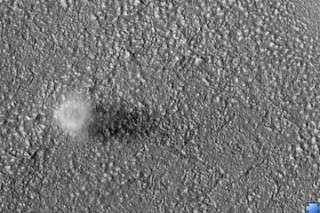Dust Devil East of Hellas Planitia (IMAGE CREDIT: NASA/JPL/University of Arizona)
The University of Arizona-based High Resolution Imaging Experiment (HiRISE) group this week released a good look at a dust devil on Mars. This is not the storm bedeviling NASA's Mars Exploration Rovers, Spirit and Opportunity.
The HiRISE camera captured the dust twister by chance in its photographic swath of a region in the southern hemisphere near Hellas Planitia during a Martian mid-afternoon early last month. The HiRISE camera is orbiting the Red Planet on NASA's Mars Reconnaissance Orbiter.
The HiRISE image is of a region east of the Hellas impact basin and south of Reull Vallis. Details on this and other new images are posted on the HiRISE website, hirise.lpl.arizona.edu .
Dust devils form when the temperature of the atmosphere near the ground is much warmer than that above. The hot air rises, and under ideal conditions, forms a vortex that sucks in more warm air. If the vortex is strong enough, it will raise dust off the surface, forming a dust devil.
Dust devils generally form in the afternoon because the sunlight needs sufficient time to warm the surface. Local time when this picture was taken was 3:08 p..m.
The bright material is the dust within the vortex. A dark shadow cast by the dust devil is visible to the right. This dust devil is about 200 meters across (about 660 feet), but probably much smaller than that where it touches the surface. Scientists estimate from the length of its shadow that the dust devil is about 500 meters tall (about 1,600 feet).
The HiRISE camera takes images of 3.5-mile-wide (6 km) swaths as the orbiter flies at about 7,800 mph between 155 and 196 miles (250 to 316 km) above Mars' surface.
Professor Alfred McEwen of UA's Lunar and Planetary Laboratory is principal investigator for HiRISE.
Source: University of Arizona
























